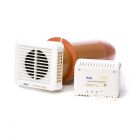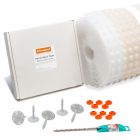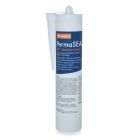Help & Advice Articles, Videos and How-to-Guides
Filter Articles

Damp Proofing Treatment and Costs
Damp problems in buildings are usually caused by condensation or penetrating damp. In some rarer cases, rising damp is the cause of the damp issues. These types of damp can all pose real problems to homeowners. They can ruin your interior decoraction, damage carpets and woodwork, and in severe cases, cause structural damage. Damp can also make your home feel unwelcoming.
Many people avoid treating damp early on because of the costs of damp proofing - they believe the treatment is expensive. This isn't often the case. Also, by delaying treatment the problem will get worse and become more expensive. If your property is suffering from damp, the best thing to do is act fast as it will save you a lot of hassle and money.
DISCLAIMER: Any costs quoted in the article are correct at the time of writing. All prices are liable to change over time.
How much does damp proofing cost?
The cost of damp proofing depends on a number of factors. These include the area affected and the solution. You also have to consider any costs associated with who does the work. The cost of damp proofing internal walls can be relatively low but resolving the route cause can be expensive.
In this article, we will examine the costs of both preventative damp proofing measures and solving issues with damp. At Permagard, we work hard to pass on savings to our customers and keep costs to a minimum whilst maintaining the highest quality.
Damp Proofing Costs
There are three main types of damp that all have unique solutions and a wide range of costs. These solutions are as follows:
Condensation
Condensation occurs when moist air comes into contact with a surface that is at a lower temperature. Warm air holds more moisture than cold air. When moist air comes into contact with either colder air or a colder surface, the air is unable to retain the same amount of moisture and the water is released to form condensation on the surface. This is most common in properties that have poor ventilation. Condensation usually forms on non-absorbant surfaces such as bathroom tiles or windows.
Condensation Treatment Costs
Condensation is relatively inexpensive to treat, providing you spot it early. There are a range of condensation control products on the market, from preventative methods to treating the effects of condensation. These span anti-condensation paint to whole house ventilation systems.
Minor condensation problems can be treated cheaply and quickly. Permagard stock a passive condensation control vent with no moving parts that is easy to install for less than £20 excluding VAT. However, more severe cases of condensation may need specialist advisors to direct you on what solutions are suitable for your property. These can include Heat Exchange Units like the Kair Heat Recovery Ventilator which costs over £240.
You can read more on your options and how much they cost in our guide to reducing condensation in your home.
Penetrating Damp
Penetrating damp can be caused by a number of different property defects. The most common causes are blocked gutters, broken or leaking pipes as well as damaged roofs. All of these faults allow moisture to seep through the building - also referred to as water ingress. Over time, the damp will become more visible as it causes damage to your interior walls and paintwork. In the winter months, the water in the walls can freeze and expand, causing paint to lift and flake.
Penetrating Damp Treatment Costs
You will first need to resolve the underlying building fault - the amount this costs will depend on the issue and the extent of the damage. Roofs tend to be more expensive to fix than leaking pipes. In terms of damp treatment costs, the most affordable and common remedy is to apply a facade cream water repellent to the outside of the property. You can do this yourself with a high quality cream-based water repellent like PermaSEAL Facade Cream. In some scenarios, it may be necessary to apply a damp proof membrane or tanking slurry to the inside walls to deal with the water ingress.
Read more:
Water Repellents for treating Penetrating Damp
Rising Damp Costs
Rising damp occurs when ground water rises through the masonry substrate of the building. You may notice rising damp as visible tide marks on your walls or mould growth in wood. Wallpaper will begin to loosen and paint will deteriorate. Externally, mortar may crumble and salt stains may appear on the walls. Steel and iron fasteners rust. It may also cause respiratory illness in occupants. In extreme cases, mortar or plaster may fall away from the affected wall.
Rising Damp Treatment Costs
Rising damp is probably the most expensive form of damp to cure. However, considering its severity, it is a job you need to get done properly. The first step is a professional diagnosis to rule out other forms of damp and make sure you do need to install a new damp proof course (DPC). Treatment usually requires a new chemical damp proof course being installed. Damp proof courses act as an impermeable barrier and protect against ground water rising up your walls. You will also need to replaster to a precise specification in order to treat salts and prevent the damp reappearing.
Read more:
Treating Rising Damp with Injection Cream
How much is a damp proof course?
The cost of new damp proof courses depends on the size of the area affected. Permagard sell a wide range of other chemical damp proof course products. Chemical DPCs are normally installed by drilling holes in the mortar course and inserting a special damp proofing injection cream. The internal walls must also be re-rendered to stop salt from reappearing.
Permagard - Low Trade Prices
If you have any questions on the costs associated with damp proofing a property or how to damp proof a barn conversion then we can help. At Permagard, we work hard to keep our products available to all at low trade prices.



